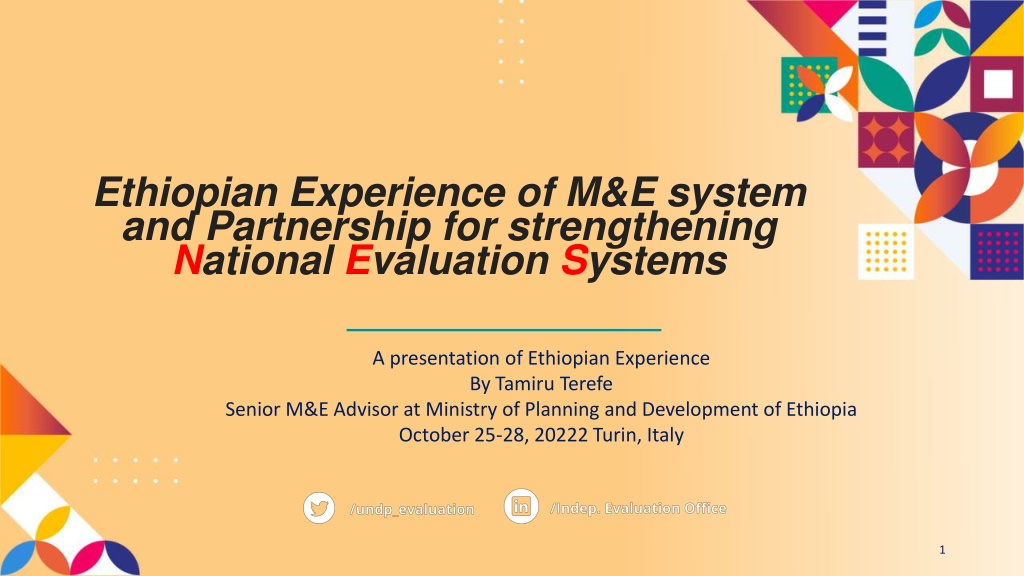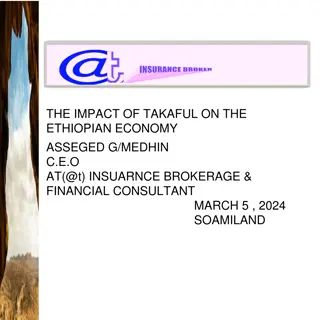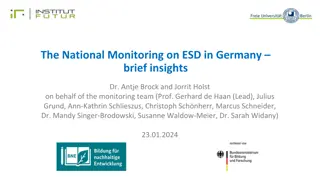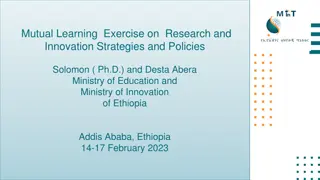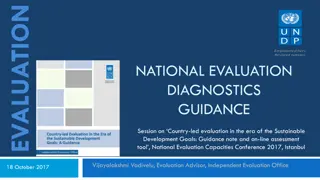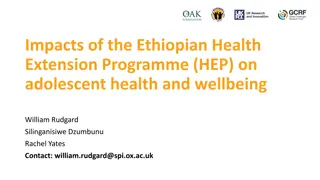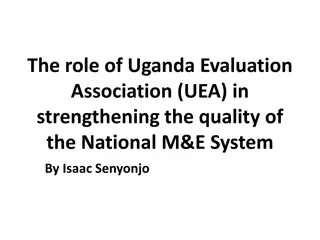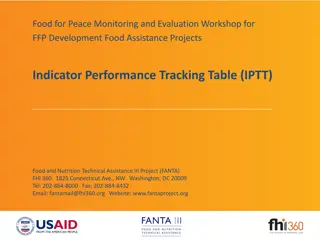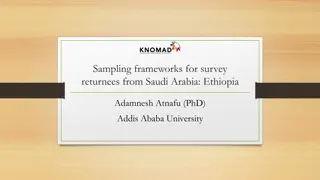Ethiopian National Monitoring and Evaluation System Overview
Ethiopian M&E system involves partnerships for strengthening national evaluation systems. The Federal Government plays a crucial role in formulating and implementing development policies and strategies. Since 2002/2003, Ethiopia has aligned with global goals, emphasizing coherent planning for economic and social development. Various stakeholders are involved in data collection, reporting, and evaluation to ensure effective performance monitoring.
Download Presentation

Please find below an Image/Link to download the presentation.
The content on the website is provided AS IS for your information and personal use only. It may not be sold, licensed, or shared on other websites without obtaining consent from the author. Download presentation by click this link. If you encounter any issues during the download, it is possible that the publisher has removed the file from their server.
E N D
Presentation Transcript
Ethiopian Experience of M&E system and Partnership for strengthening National Evaluation Systems A presentation of Ethiopian Experience By Tamiru Terefe Senior M&E Advisor at Ministry of Planning and Development of Ethiopia October 25-28, 20222 Turin, Italy 1
Content National M&E System: Ethiopia Challenges Major interventions Way forward
National NationalM&E the FDRE FDRE provides provides power national policies, policies, strategies and development development matters matters Development Planning has been an instrument to implement national and sectoral policies and strategies The The Federal Federal Government Government is is thus thus responsible responsible to to develop coherent coherent and and horizontally horizontally consistent consistent plan plan based priorities priorities NDPs NDPs are are also also used used to to implement implement mainstreaming mainstreaming them them into into the the plan plan. . Since Since 2002/2003 2002/2003, , Ethiopia Ethiopia has has implemented implemented four four medium mainstreaming mainstreaming global global goals goals and and now now implementing implementing the Hence, there is one plan and one report system to serve all stakeholders interests in development process. M&ESystem: System:Ethiopia power to to the the Federal Federal Government strategies and and plans plans with with respect Ethiopia Government to to formulate respect to to overall overall economic, The The Constitution Constitution of of the implement implement national and formulate and economic, social and social develop and on national national development and implement implement vertically development needs vertically needs and based on and global global and and regional regional goals goals by by effectively effectively medium term the TYDP term development development plans TYDP. . plans by by 8/5/2024 3
National M&E system Development DevelopmentPlanning, Planning,M&E M&Edata dataflows flows National policies, directivesand working mechanisms/Frameworks House of People's Representatives Office of the PrimeMinster Ministry of Planning and Development Civilsocieties,DAG, Private sectors Regional governments PresidentOffice NationalStatistical Development Strategy Federalsector ministries/agencies Federal level Development stakeholders Ethiopian Statistical Services Regional BoFED/PDC Regional secretor Bureaus Regional level development stakeholders Zone/Woreda Sector bureaus Zone/WoredaOFEC/PDC office DigitalM&E Annual,mid year andTerminal monitoring and Evaluation report Development performance data
National M&E system. Stakeholders Universities and Research Institutions Famers and Pastoralists Youth and Women The private sector Civic Society Organizations(CSOs) Development Partners(DPs) Others . (AU, IGAD, COMESA, NEPAD
National M&E System. InstitutionalArrangements and coordination Coordinating the implementation of the plan, preparing national progress reports, Organizing consultative forums Preparing and Disseminating M&E results Building the national M&E system MoPD Monitoring and evaluating their respective sector plans, Reporting to various government bodies Generating and using administrative data Sector Ministries: Producing census and survey data, Ensuring the quality of data and disseminating data for use in development planning, policy analysis ESS
National M&E System. Examples of mainstreaming global development agendas in planning, M&E processes Link with SDGs targets 2019/20 2020/21 2021/22 2022/23 2023/24 2024/25 2025/26 2026/27 2027/28 2028/29 2029/30 KPIs baseline target target target target target target target target target target Education Pre-Primary Gross Enrollment Rate Pre-Primary Net Enrollment Rate 41.8 48.26 54.72 61.18 67.6 74.1 80.56 87.2 93.48 100 100 SDGs 4.2.1, SDGs 4.2.2 70 77 85 92 100 23.9 32 39 47 54 62 Primary education Gross Enrolment 115.2 113.54 11.88 110.22 108.6 106.9 105.24 103.58 101.92 100 100 SDGs 4.1.1 Primary education net enrolment ratio Gender Parity Index (GPI) in pre- primary 100 100 100 100 100 100.2 100 100 100 100 100 0.95 0.96 0.97 0.98 0.99 1 1 1 1 1 1 SDGs 4. 5.1
National M&E system. The M&E system enables to monitor andevaluate theperformance of thenationalplanatdifferent levelsi.e.macroandsectoral The National M&E System is exercised fairly ina participatory and transparentmanner that involves Donors, CSOs and Private sectors Annual Progress Reports are published after approved by the government Consultations are made on reports at regional and federal levels with variousstakeholdersand citizensat differentlevels Achievements are made official through various channels (media, websites and other mechanisms) The system further enables the country to monitor and evaluate global and continental development frameworks (Agenda 2063, SDGs) as they are mainstreamed in the national development plan Poverty Analysis and Human Development Reports have also been prepared to assess the impact of growth on poverty reduction and Human development
Challenges Misconceptions about M&E/Negative mind-set particularly on RBME Gaps in National Capacity (Manpower, M&E units and System) across government institutions at all levels Weak Weak capacity capacity and and appetite appetite in in relation relation to to rigorous monitoring monitoring Challenges Challenges related related to to quality quality and and consistency Challenges related to effective dissemination and using of M&E results Lack ofcoordination and integration among/between actors and stakeholders both at national and subnational levels. rigorous evaluation evaluation and focus only on and focus only on consistency of of M&E M&E data data
Major Interventions A series of M&E capacity gap assessment have been conducted both in house and in collaboration with AfDB, USAID, UNDP, World Bank at sectoral and national level. National M&E Guideline has been developed and accordingly Monitoring system is paving the way to further strengthen the M&E system. Prepare KRA and KPI master reporting format Digital Monitoring and reporting Capacitating the M&E units of sector ministires MoPD in collaboration with UNICEF, has conducted National Evaluation Capacities Readiness Assessment and National Evaluation Capacity Development Plan. The NECRA assessment has delt with vision and framework specifically with understanding how evaluation can contribute to the 10-year development plan and SDGs implementations, The rationale for the existence of evaluation directorates is formalized, existence of clear articulation between evaluation related policies, M&E guidelines and evaluation directorates expected outputs and outcomes, the existing yearly implementation plans to achieve the desired evaluation objectives. Based on the assessment, there is more-or-less a shared understanding of how evaluations can contribute to the 10- year Development Plan and the SDG achievement. .
The Way Forward Making M&E a prominent political priority and boost demand and intensive use of M&E information at all levels of the government. Improve the current institutional incentive (ensure that MoPD has strong incentive mechanisms to get the full commitment of Federal and Regional Institutions) Working closely with various actors/stakeholders (CSOs, academia, development partners and private sector) to improve national evaluation capacity Implement the capacity development plan suggested during NECRA Assessment (Developing organizational capacity, individual capacity and realizing conducive environment. Further strengthen the partnership with Donors and UN Agencies for collaborations in Evaluations, capacity development training and cash disbursement.
